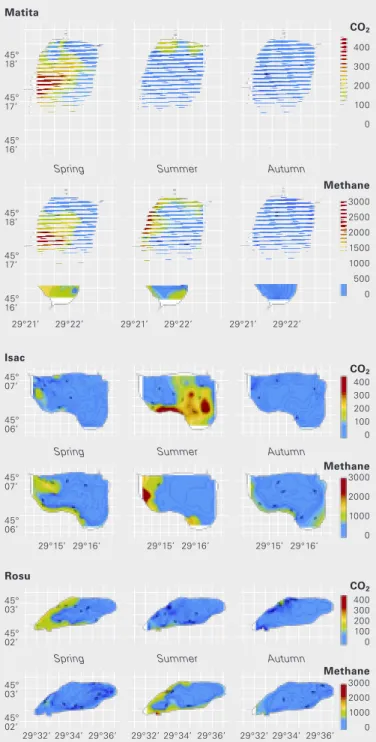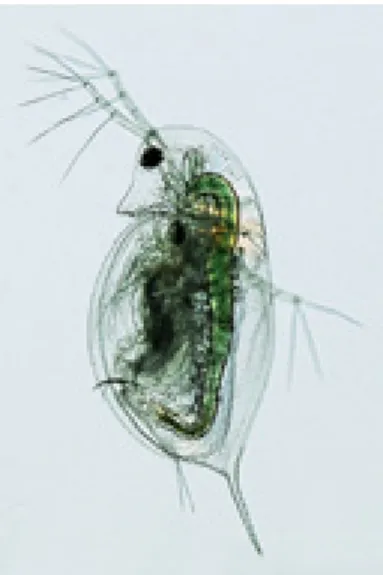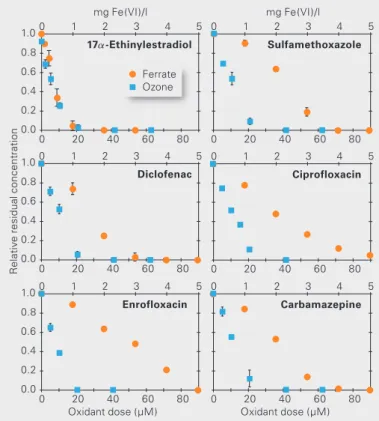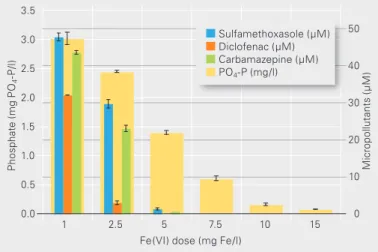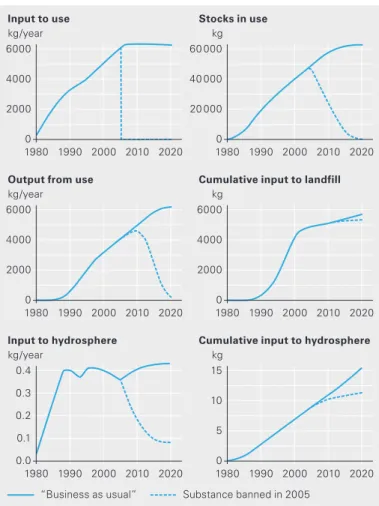Daphnia species that disappeared as a result of eutrophication have not yet been restored, despite the obvious improvement in the state of the lakes. Decomposition of biomass in the Danube Delta creates particularly large amounts of the greenhouse gases methane and carbon dioxide, which are released into the atmosphere. In collaboration with researchers from the Romanian National Institute for Marine Geology and Geoecology (GeoEcoMar), we have carried out detailed studies of various lakes in the Danube Delta [3 – 5].
Nutrients are transformed most efficiently in the lakes that lie near the main tributaries of the Danube. These are produced over a season and gradually sink to the bottom of the lake, where they are covered by newly deposited sediments.
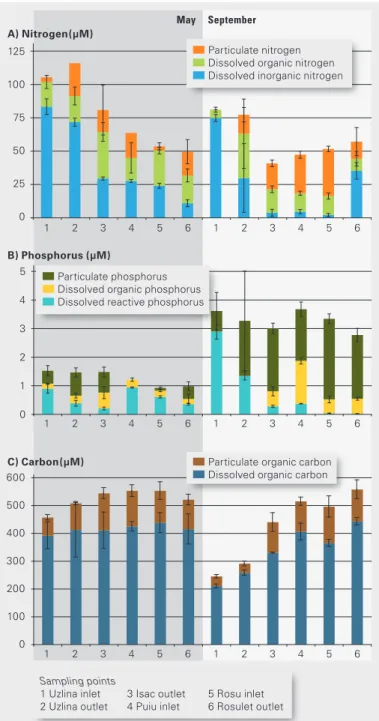
Brienz and Lake Lugano
At the same time, there is an increase in the proportion of unsaturated compared to saturated fatty acids (bars in Fig. 1B). However, the fatty acid concentrations tend to rise again in the deep water of Lake Lugano - here the degradation seems to proceed more slowly. We detected a high relative abundance of these compounds in the euphotic zone of Lake Brienz in spring and autumn.
The dashed line marks the oxic-anoxic boundary in the water column of Lake Lugano. For example, these were found in the spring in the euphotic zone of Lake Luhansk. In contrast, the polyunsaturated fatty acids that appear in Lake Brienz and in the euphotic zone of Lake Lugano in the fall originate mainly from diatoms.
Both of these sterols were detected in samples collected in spring from Lake Brienz and Lake Lugano. As expected, less organic matter is produced in the oligotrophic Lake Brienz than in the eutrophic Lake Lugano. At the same time, organic matter is degraded more efficiently in Lake Brienz than in Lake Lugano, so overall more organic carbon is sequestered in the sediment of Lake Lugano.
Due to elevated nutrient concentrations, oxygen levels in Lake Lugano are only comparable to Lake Brienz in the uppermost water layers (Figure 1A).
Why Lake Lugano’s waters
As salinity increased with depth, the lake was chemically stratified and complete mixing was no longer possible. Because the lake is so deep and the salinity gradient—stratification—was so stable, large-scale mixing was not possible. And the goal of our study was to reconstruct exactly how these mixing events happened.
We calculated that in the winter of 2006 approximately half of the deep water volume was exchanged. Yes, after seeing that Lake Lugano was fully mixed again for the first time in many years in the winter of 2005, we collected samples from the lake in the spring of 2005 and 2006 and did trace analyses. We know how the atmospheric concentrations have changed over the years, and this can be traced in the water - because the water is connected to the atmosphere through gas exchange.
But you still can't reason based on the water age, even though it would be much more intuitive. Now that concentrations in Lake Lugano have leveled off, mixing will occur more frequently in the future. Complete mixing caused major changes in the ecological structure of the lake, and vertical water transport became possible.
Some scientists predict that the mixing of our lakes will decrease in the future due to a warming climate. The same argument is always used: the surface water warms, resulting in an increased density gradient and reduced mixing of the lake. Then the temperature difference in the lake between summer and winter will probably be as great as it is today, albeit in a generally warmer regime.
Are you saying that warming the climate will have positive effects on the mixing behavior of the lakes.
Over the past decade, significant technological advances have been made in decentralized wastewater treatment systems, which in the past were often dismissed as inefficient. For this reason, says Tove Larsen (head of the 'Future Concepts' working group of the Urban Water Management Department), new concepts in wastewater treatment from a global perspective are increasingly shaped by the issue of water scarcity. For example, as in Switzerland, centralized wastewater treatment plants (WWTPs) also play a key role in the western US.
This would be possible either if gas cleaning were included in the method, or if nitrogen,. In the case of phosphorus, eutrophication is not the only issue: this is a limited resource and supplies are likely to run out in about a century. Kai Udert, a researcher in the Process Engineering department, is currently working on improving the energy balance.
In the On-Site water Treatment technology (OST) project, which includes the departments Innovation Research in Utility Sectors (Cirus) and Urban Water Management, Eawag is conducting a global analysis of the concepts of decentralized systems. In other words, he believes that the choice of a decentralized system is likely to be more appropriate in the presence of greater uncertainties. In a similar way to ozone, ferrate also attacks electron-rich parts of micropollutant molecules.
E-phenols, for example contained in the endocrine disruptors 17a-ethinyl estradiol, 17b-estradiol, bisphenol A and the biocider triclosan;.
15 mg Fe/l was required to achieve 40% oxidation of the lipid-lowering agent bezafibrate and the contrast agent iopromide, and only 10% oxidation was achieved with the same dose in the case of the analgesic and anti-inflammatory drug ibuprofen [ 3 ]. Only one of the investigated compounds, 17α-ethinyl estradiol, was oxidized roughly equally efficiently by both oxidants. In subsequent studies of the kinetics of oxidation reactions, the rate constants (k-values) of the reactions of the analyzed micropollutants were found to be three to four orders of magnitude lower for ferrate than for ozone [3].
In fact, based on previous experiments, we would expect the values here to be much higher. To understand this, it is necessary to consider the stability of each of the oxidants in the wastewater. Kinetics of oxidation of phenols and phenolic endocrine disruptors during water treatment with ferrate (Fe(VI)).
During the oxidation of micropollutants and other wastewater components, and as a result of self-decomposition, ferrate [Fe(VI)] is reduced to Fe(III). Overall, our studies showed that ferrate is suitable for the oxidation of micropollutants in wastewater. Therefore, it may make sense, in terms of operating costs of a WWTP, to use ferrate to ensure complete oxidation of reactive micropollutants, achieving some degree of phosphate precipitation in the process.
A comprehensive ferrate cost analysis should also take into account the savings resulting from the simultaneous removal of phosphates and the lower investment costs required for the necessary infrastructure compared to ozone (using existing feed systems for iron phosphate precipitation). .
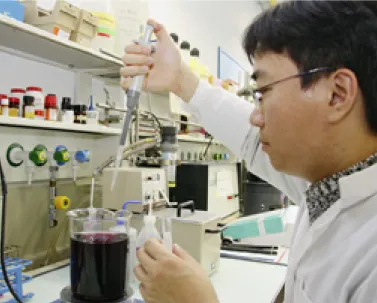
Assessment of chemicals
A promising option – in addition to computer-based prediction models and zebrafish embryo tests – is the use of fish cells (see Box). Despite the considerable potential of this approach, the use of fish cells has not yet been included in any legally defined test.
The more lipophilic the test compound, the more it will bind both to the walls of the test wells - especially when made of plastic - and to proteins present in the culture medium. Both of these factors – lipophilicity and volatility – thus reduce the availability of chemicals, leading to lower sensitivity of the test system. However, this can easily be done by determining the free concentration of the substance in the medium.
With direct dosing, the EC50 (ie the concentration that causes 50% cell death) is 5 times lower. In this case, sorption of the chemical to proteins can be neglected, since our exposure medium (L15/ex) does not contain any proteins. Therefore, if intrinsic lethal concentrations are considered, differences in sensitivity between direct and indirect dosing are eliminated, and the measured toxic effects are independent of the dosing procedure.
However, to give an accurate account of the sensitivity of fish cells, toxicity data must always be based on the actual internal concentration. 2: (A) Schematic illustration of direct and indirect dosing. B) The location of the dose-response curves and therefore also the EC50 values for 1,2-dichlorobenzene DCB depends on the dosing procedure. Ruth Scheidegger, scientist in the "Material flows in the anthroposphere" section of the Systems Analysis, Integrated Assessment and Modeling section.
Consider, for example, the life cycle of a sofa: here, brominated flame retardants are incorporated directly into or applied to the surface of the materials used in the production process.
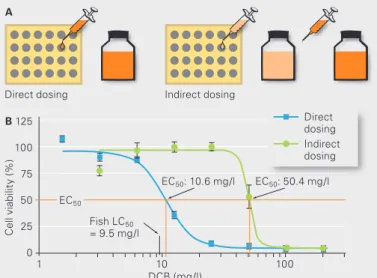
From source to sink
The model takes into account the fact that in the past some of the products that were disposed of were directly dumped. However, even if the use of HBCD is regulated soon, we will not be rid of the substance for some time. Bogdal C., Schmid P., Zennegg M., Anselmetti F.S., Scheringer M., Hungerbühler K. Blast from the past: Melting glaciers as a relevant source for persistent organic pollutants. 2009): Biozide in Gebäudefassaden – ökotoxicologische Effekte, Auswaschung en Belastungsabschätzung für Gewässer.
Research Partnerships for Sustainable Development in Southeast Asia, NCCR North-South, JACS SEA, Thailand, 1 p. 2009): Geochemical and hydrological controls on the mobilization of arsenic from herbicide application. Modeling lakes and reservoirs in the climate system. 2009): Macro and microspectroscopic study of Nd (III) uptake mechanisms in hardened cement paste. Thielsch A., Brede N., Petrusek A., De Meester L., Schwenk K. 2009): Contribution of cyclic parthenogenesis and colonization history to population structure in Daphnia.
After a successful pilot project on Lake Lucerne, Eawag has now started investigating the bottom of the Swiss part of Lake Maggiore. This data can be processed to produce three-dimensional images of the lake bottom with centimeter-scale accuracy. Researchers can use this precise data to track the historical development of the lake.
For example, they focus on the small, round depressions observed in the northern part of the Ticino/Verzasca delta.

Measuring rainfall with mobile phone antennas
Toxic arsenic removed from fields by monsoon floodwaters
New member of Directorate
Jukka Jokela
Agenda
Watt d’Or energy award for Eawag
Groundwater conference GQ 10
